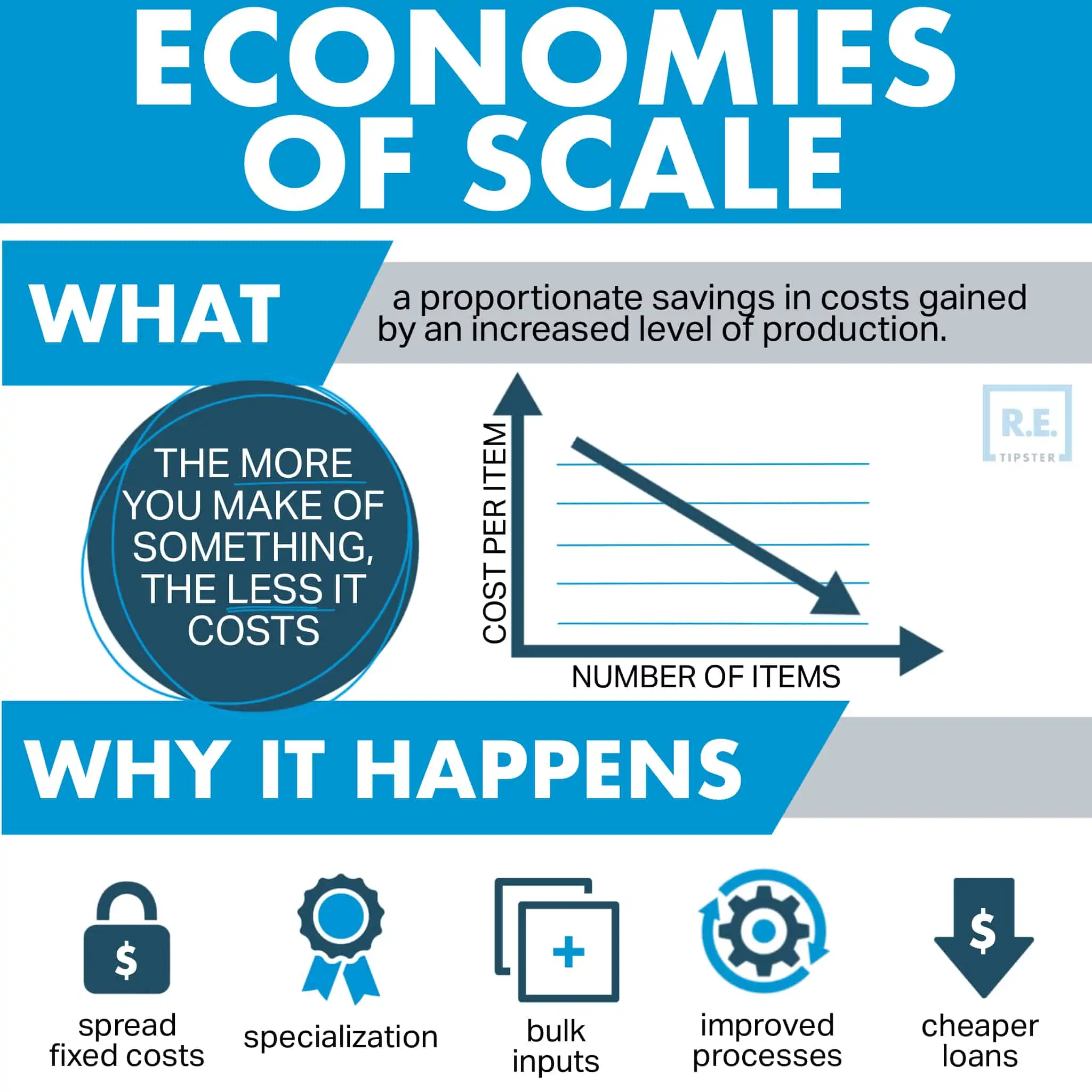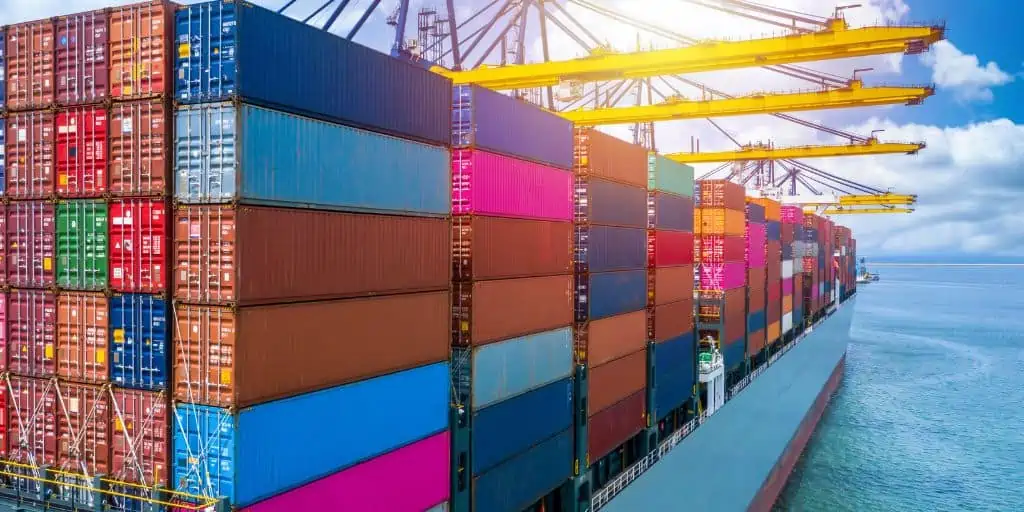What Are Economies of Scale?
REtipster does not provide tax, investment, or financial advice. Always seek the help of a licensed financial professional before taking action.
How Are Economies of Scale Achieved?
Companies achieve economies of scale by making production more efficient on lower fixed and variable costs[1].
When a business arrives at an economy of scale, it is said to have “scaled” its operations over a larger number of production units, therefore spreading the costs of production. In other words, the average costs per unit are lower with a higher output volume.

For example, take two companies, Company A (small business) and Company B (large business), both in the business of producing pairs of shoes. Both companies have the same production budget, which is $100 million, but Company B has a much larger production capacity, delivering 100,000 pairs while Company A only produces 1,000 in the same amount of time.
In this example, Company B has a better economy of scale than Company A. Company B’s average production cost is much lower ($100 million / 100,000 = 1,000 per unit). By contrast, Company A spends 100x more on units produced ($100 million / 1,000 = 100,000).
Economies of scale represent a bigger business’s competitive advantage by the sheer size of its production. As a result, the bigger the business, the more it can derive value from its production[2].
Larger companies can achieve economies of scale because they have more opportunities and means to tap production increases. These opportunities can either be internal or external.
Factors That Affect Economies of Scale
Certain factors trigger economies of scale, which can be classified into two main categories[3]:
- Internal economies of scale. This refers to underlying factors within the company or business that deliver cost benefits. A supermarket chain, for example, can get lower pricing from its bulk orders than a family-run grocery store.
- External economies of scale. These cost savings occur outside the policies and operations of the business, and usually without its control. Examples are government policies that affect an entire industry, such as an initiative to offer tax breaks to shoemakers with more than 10,000 workers. Those with fewer employees, such as Company A in the example above, may try to achieve economies of scale by hiring more workers and boosting production[4].
These two categories can be further divided into several subtypes.
Internal Economies of Scale
Internal economies of scale are further classified into six types[5]:

Shipping companies can invest in bigger cargo ships to transport goods in bulk, lessening overall shipping costs.
- Technical. Optimizations and improvements in the production process deliver economies of scale. This is an experience-based exercise where companies invest in more efficient facilities to improve their operations and reduce production costs.
- Managerial. This applies when companies employ a specialized workforce or hire additional experts to form key business units. The result is more efficient management and a more productive business organization. Employees can focus on their expertise while learning by working alongside qualified and experienced peers.
- Marketing. Economies of scale can be derived from the budget for advertising and marketing as output increases. Companies can spread their fixed marketing expenses over their larger output, thus cutting per-unit costs. Additionally, large companies often carry the clout of a strong brand. This enables them to reach more consumers with better advertising deals than smaller businesses.
- Financial. Access to capital at appealing rates is often the norm as business organizations grow. These companies’ higher credit rating enables them to easily raise funds for an expansion that can further increase production. The financial stability of these companies can also be a platform for them to tap secondary markets.
- Commercial. Large companies can generate economies of scale from the price discounts they enjoy from their bulk purchases. For example, a sizable corporation has bargaining power when buying large quantities of raw materials. With the discounts these companies get, they can significantly reduce the per-unit costs of the products they manufacture and sell.
- Network. This happens when a business’s customer base grows passively. When a larger business has grown enough, customers naturally start to refer people they know to the business. As a result, it reduces the business cost of acquiring new customers from scratch.
External Economies of Scale
Economies of scale can arise due to factors beyond the control of an individual company. External factors may cut across entire industries or affect one in particular.
External sources of economies of scale occur due to one or a combination of the following[6]:
Silicon Valley is the result of an economy of scale by infrastructure.
- Infrastructure. When businesses cluster together in one area or region, they can benefit from the existing supply and infrastructure networks. The peer companies also jointly gain an advantage when the government expands or improves existing infrastructure to further stimulate production.
- Skilled labor. A corollary to the previous point, industry-specific businesses in one region draw skilled labor to its fold. This gives companies easy access to qualified employees and allows them to spend less on recruitment. Businesses in worker-populated areas also have a deeper pool of human resources to boost productivity[7].
- Tax concessions. Local, state, and federal governments typically offer tax concessions as incentives to certain industries they want to promote. These incentives are designed to provide a stable footing for industry and pave the way to lower the cost of doing business[8].
- Innovation. Many companies cluster around research and development centers on efficient production methods. Doing so enables them to quickly tap a common resource to improve their production process without spending too much on R&D[9].
- Information. Companies near each other enjoy transparency on the pricing of their common suppliers. This eliminates discriminatory pricing and helps reduce overall average production costs.
- Lobbying. As industries grow in significance, they gain more bargaining power with governments. The companies gain more leverage to negotiate with governments on matters where they can cut costs or increase profitability.
Advantages of Economies of Scale
Achieving economies of scale offers several advantages[10]:
- Price reduction. Businesses able to achieve economies of scale have the opportunity to lower their prices and generate more sales.
- Better staff compensation. The reduced unit production costs open the possibility of raising employee pay scales. Training and recruiting an additional workforce is another benefit of economies of scale.
- Improved investors’ returns. A company can reduce its total financial overhead with economies of scale, thus boosting its bottom line. With the increased profitability, there is more room for increased dividends to investors or shareholders.
- Expansion opportunities. With low production costs, a company gains more financial flexibility for expansion to other markets.
Diseconomies of Scale
A company, however, has to weigh its expansion plans carefully. When a business grows too large too quickly, it runs the risk of diseconomies of scale.
A diseconomy of scale occurs when a company’s average production costs increase relative to a certain level of its production.
A company undergoing a diseconomy of scale has lost its efficiency[11].
Takeaways
- Economies of scale refer to the cost advantages that a business enjoys because of increased efficiency in production (also known as scaling its operation, hence the name).
- Economies of scale can be either internal (due to company processes or business endeavors) or external (influenced by factors beyond the company’s control, such as government policies).
- This concept represents the competitive advantages of a bigger company over a smaller one due to the better and wider selection of opportunities it can employ.
Sources
- Kenton, W. (2021.) Economies of Scale. Investopedia. Retrieved from https://www.investopedia.com/terms/e/economiesofscale
- Mindtools. (n.d.) Achieving Economies of Scale: Understanding Why Bigger Can Be Better. Retrieved from www.mindtools.com/pages/article/newSTR_63
- Boyce, P. (2021). Economies of Scale Definition. Boyce Wire. Retrieved from https://boycewire.com/economies-of-scale/
- Corporate Finance Institute. (n.d.) Economies of Scale. Retrieved from https://corporatefinanceinstitute.com/resources/knowledge/economics/economies-of-scale/
- Zeder, R. (2020.) Types of Internal Economies of Scale. Quickonomics. Retrieved from https://quickonomics.com/types-of-internal-economies-of-scale/
- Corporate Finance Institute. (n.d.) External Economies of Scale. Retrieved from https://corporatefinanceinstitute.com/resources/knowledge/strategy/external-economies-of-scale/
- Pettinger, T. (n.d.) External Economies of Scale. Economics Help. Retrieved from https://www.economicshelp.org/blog/glossary/external-economies-of-scale/
- O’Connell, B. (2018.) Economies of Scale: Definitions, Types and Examples. The Street. Retrieved from https://www.thestreet.com/personal-finance/education/economies-of-scale-14769645
- Lecture Notes. (n.d.) External Economies of Scale Definition and Types with Examples. Retrieved from http://studylecturenotes.com/external-economies-of-scale-definition-and-types-with-examples/
- Mathur, V. (2022.) Economies of Scale: Types, Advantages and Disadvantages. Analytic Steps. Retrieved from https://www.analyticssteps.com/blogs/economies-scale-types-advantages-and-disadvantages
- Investopedia. (2021.) Diseconomies of Scale. Retrieved from https://www.investopedia.com/terms/d/diseconomiesofscale






